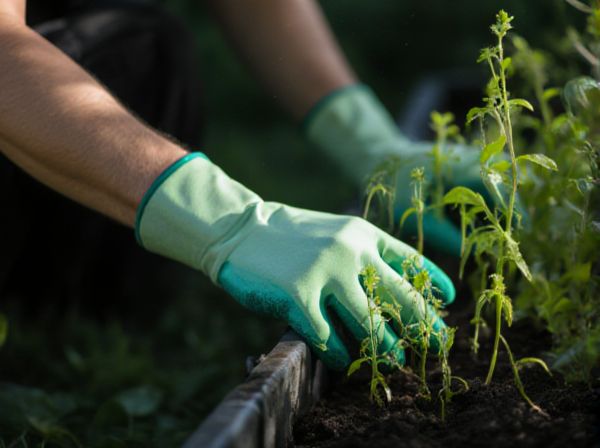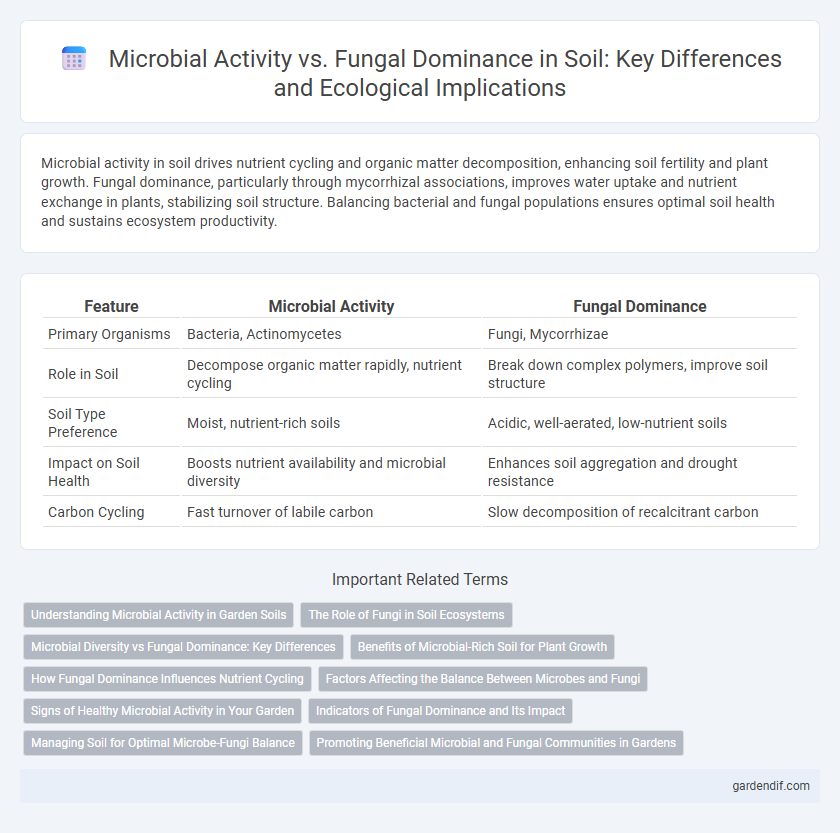
Microbial activity vs Fungal dominance Illustration
Microbial activity in soil drives nutrient cycling and organic matter decomposition, enhancing soil fertility and plant growth. Fungal dominance, particularly through mycorrhizal associations, improves water uptake and nutrient exchange in plants, stabilizing soil structure. Balancing bacterial and fungal populations ensures optimal soil health and sustains ecosystem productivity.
Table of Comparison
| Feature | Microbial Activity | Fungal Dominance |
|---|---|---|
| Primary Organisms | Bacteria, Actinomycetes | Fungi, Mycorrhizae |
| Role in Soil | Decompose organic matter rapidly, nutrient cycling | Break down complex polymers, improve soil structure |
| Soil Type Preference | Moist, nutrient-rich soils | Acidic, well-aerated, low-nutrient soils |
| Impact on Soil Health | Boosts nutrient availability and microbial diversity | Enhances soil aggregation and drought resistance |
| Carbon Cycling | Fast turnover of labile carbon | Slow decomposition of recalcitrant carbon |
Understanding Microbial Activity in Garden Soils
Microbial activity in garden soils plays a crucial role in nutrient cycling and organic matter decomposition, directly influencing plant health and soil fertility. Fungal dominance often enhances soil structure and supports nutrient uptake by forming symbiotic relationships with plant roots, particularly through mycorrhizal associations. Balancing bacterial and fungal populations optimizes microbial processes, promoting a resilient and productive garden ecosystem.
The Role of Fungi in Soil Ecosystems
Fungi play a crucial role in soil ecosystems by decomposing complex organic matter, such as lignin and cellulose, which bacteria cannot efficiently break down. Their extensive mycelial networks improve soil structure and facilitate nutrient cycling by mobilizing phosphorus and nitrogen essential for plant growth. Fungal dominance often indicates a stable, mature soil environment with enhanced carbon storage and resilience against pathogens.
Microbial Diversity vs Fungal Dominance: Key Differences
Microbial diversity in soil encompasses bacteria, archaea, and fungi, promoting nutrient cycling and enhancing soil structure, whereas fungal dominance often occurs in stressed or nutrient-poor environments, leading to slower organic matter decomposition. High microbial diversity supports resilient ecosystems by facilitating diverse metabolic functions, while fungal dominance may limit this diversity, impacting soil fertility and plant health. Understanding the balance between microbial diversity and fungal dominance is crucial for optimizing soil ecosystem services and agricultural productivity.
Benefits of Microbial-Rich Soil for Plant Growth
Microbial-rich soil enhances nutrient cycling by breaking down organic matter into plant-available forms, promoting healthier root development and increased nutrient uptake. This microbial diversity improves soil structure, water retention, and disease resistance, creating an optimal environment for plant growth. Fungal dominance, while beneficial for mineral nutrient mobilization, is often complemented by microbial bacteria that accelerate decomposition and nitrogen fixation, collectively boosting plant productivity.
How Fungal Dominance Influences Nutrient Cycling
Fungal dominance in soil enhances nutrient cycling by breaking down complex organic matter such as lignin and cellulose, which bacteria cannot efficiently decompose. This process releases essential nutrients like nitrogen and phosphorus more slowly and steadily, fostering long-term soil fertility. Moreover, fungal hyphae improve soil structure, increasing water retention and nutrient availability to plants.
Factors Affecting the Balance Between Microbes and Fungi
Soil moisture, pH, and organic matter content critically influence the balance between microbial activity and fungal dominance, where higher moisture and neutral pH favor bacterial growth while acidic, drier conditions promote fungal proliferation. Nutrient availability, particularly carbon-to-nitrogen ratio, also shifts this balance, as fungi efficiently decompose complex organic compounds in nutrient-poor soils compared to bacteria. Temperature and soil disturbance further modulate microbial and fungal populations by altering habitat conditions and resource accessibility, impacting soil health and nutrient cycling.
Signs of Healthy Microbial Activity in Your Garden
Signs of healthy microbial activity in your garden include crumbly soil structure, rich organic matter decomposition, and vigorous plant growth with minimal disease. Abundant earthworms and diverse microbial populations, such as bacteria and beneficial fungi, indicate balanced soil biology. Maintaining optimal moisture and aeration supports fungal dominance when necessary, enhancing nutrient cycling and disease suppression.
Indicators of Fungal Dominance and Its Impact
Indicators of fungal dominance in soil include increased hyphal length, elevated ergosterol concentrations, and a higher fungal-to-bacterial biomass ratio, reflecting a shift in microbial community structure. This dominance influences soil nutrient cycling by enhancing the decomposition of complex organic matter like lignin, promoting soil aggregation through hyphal networks, and improving water retention. Fungal-dominated soils often exhibit increased resistance to pathogens and greater carbon sequestration potential, impacting overall ecosystem function and soil health.
Managing Soil for Optimal Microbe-Fungi Balance
Managing soil for an optimal microbe-fungi balance requires regulating moisture levels and organic matter content to support diverse microbial habitats. Excessive fungal dominance often results from high carbon availability and low nitrogen conditions, which can be moderated through targeted nutrient amendments and crop rotation strategies. Promoting microbial activity alongside fungi enhances nutrient cycling efficiency, improving soil structure and plant health.
Promoting Beneficial Microbial and Fungal Communities in Gardens
Enhancing soil health in gardens hinges on fostering a balanced microbial activity and fungal dominance that supports nutrient cycling and disease suppression. Applying organic matter such as compost and mulching promotes beneficial microbial populations, while mycorrhizal fungi inoculants improve root nutrient uptake and soil structure. Regular monitoring of soil pH and moisture further encourages diverse microbial and fungal communities essential for sustainable plant growth.
Microbial activity vs Fungal dominance Infographic

 gardendif.com
gardendif.com